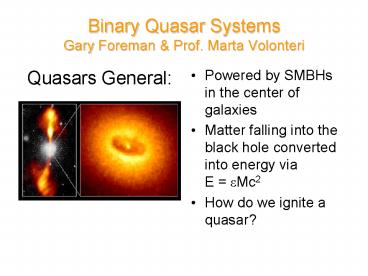Binary Quasar Systems Gary Foreman - PowerPoint PPT Presentation
1 / 11
Title:
Binary Quasar Systems Gary Foreman
Description:
Time it takes for black hole mass to increase by a factor of e if the quasar is shining at LEdd ... find that our black hole masses are consistent with those ... – PowerPoint PPT presentation
Number of Views:63
Avg rating:3.0/5.0
Title: Binary Quasar Systems Gary Foreman
1
Binary Quasar SystemsGary Foreman Prof. Marta
Volonteri
- Quasars General
- Powered by SMBHs in the center of galaxies
- Matter falling into the black hole converted into
energy via E eMc2 - How do we ignite a quasar?
2
Galactic Mergers start accretion
120 kpc
8 kpc
1 pc 3.26 ly 3.09 1018 cm
60 kpc
8 kpc
Galactic merger simulation from Mayer et al.
(2007)
160 pc
3
Quasars Theory
- Assume All quasars are the offspring of
galactic mergers? - Assume All galaxies contain SMBHs that accrete
sometime during merger? - Black holes should stop accreting by the time the
galactic merger is over (Hopkins et al. 2005) - Quasars are observable for 107 yr?
tEdd 0.14.5108 yr
4
What is Eddington time (tEdd)?tEdd e 4.5108 yr
- tEdd quasar lifetime
- Time it takes for black hole mass to increase by
a factor of e if the quasar is shining at LEdd - LEdd is the maximum luminosity of the quasar
- Radiation pressure from accreting matter balances
gravitational force on in falling gas - Eddington ratio LBH / LEdd
Sir Arthur Stanley Eddington
5
Quasars Observation
- 100,000 quasars have been observed
- 0.1 of observed quasars are binaries
- Why so few?
6
Our Sample 95 Quasar PairsKochanek, Falco,
Muñoz (1999) Hennawi et al. (2006)Mortlock,
Webster, Francis (1999) Myers et al. (2006)
- Sloan measures
- g- and u-band magnitudes
- g-band 469 nm (blue/green light)
- u-band 355 nm (ultraviolet light)
- Redshifts (z)
- Angular separations (arcseconds)
7
Our Calculations
8
Results
- We find that our black hole masses are consistent
with those reported in Warner, Hamann, and
Dietrich (2003) - Masses are on the high side
9
Dynamical Friction Timescales
How long does it take for galactic components to
merge?
- Dark Matter Halos merge in 7 Myr
- Stellar Bulges merge in 110 Myr
- Black Holes merge in 24 Gyr
10
Why is the Halo merging time so short?
- Halo merging time may be too short as many small
quasar separations imply that halo merging is
already underway
11
Conclusions
- tEdd / tDF should equal 0.001
- However
- 107 / (7.0 106) 1.43
- 107 / (1.1 108) 0.09
- ???
- Quasar lifetime has been overestimated?
- Quasars obscured by the dust that powers them?
- Galactic mergers arent the only way to ignite
quasars? - Not all galaxies host a SMBH?































